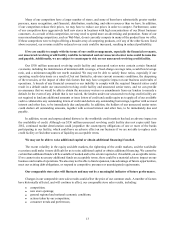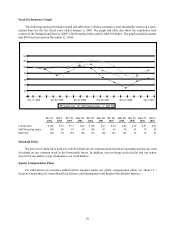Cabela's 2009 Annual Report Download - page 30
Download and view the complete annual report
Please find page 30 of the 2009 Cabela's annual report below. You can navigate through the pages in the report by either clicking on the pages listed below, or by using the keyword search tool below to find specific information within the annual report.21
backed securities, and accounting and regulatory changes and relations could make such financing more difficult or
impossible to obtain or more expensive. We have been particularly reliant on funding from securitization transactions
for our Financial Services business. Securitization funding sources include both variable funding facilities and fixed
and floating rate term securitizations. A failure to renew these facilities, to resecuritize the term securitizations
as they mature, or to add additional term securitizations and variable funding facilities on favorable terms as it
becomes necessary could increase our financing costs and potentially limit our ability to grow our Financial Services
business.
Furthermore, even if we are able to securitize our credit card loans consistent with past practice, poor
performance of our securitized loans, including increased delinquencies and credit losses, lower payment rates, or a
decrease in excess spreads below certain thresholds, could result in a downgrade or withdrawal of the ratings on the
outstanding securities issued in our securitization transactions, cause “early amortization” or “early redemption” of
these securities, or result in higher required credit enhancement levels. This could jeopardize our ability to complete
other securitization transactions on acceptable terms, decrease our liquidity, and force us to rely on other potentially
more expensive funding sources, to the extent available, which would decrease our profitability.
The volatility and disruption of the capital and credit markets as well as downgrades of the ratings on
the outstanding notes issued by our Financial Services business’ securitization trust may negatively impact
our ability to access financing.
While we intend to finance our growth initiatives and operations with existing cash, cash flow from operations,
and borrowings under our existing revolving credit facility, we may require additional financing to support our
growth initiatives and operations. Our Financial Services business historically relied on funding from securitization
transactions to fund a significant portion of its cash requirements. Deterioration in the global capital markets has
caused financial institutions to seek additional capital, merge with larger financial institutions and, in some cases,
fail. These conditions have led to concerns by market participants about the stability of the financial markets
generally and the strength of counterparties, resulting in a contraction of available credit, even for the most credit-
worthy borrowers. These conditions have also negatively impacted the market for asset-backed securities. In 2009,
the Federal Reserve Bank of New York implemented the Term Asset-Backed Securities Loan Facility Program
(“TALF”) in an effort to facilitate the issuance of asset-backed securities and improve the market conditions for
asset-backed securities generally. The TALF program is currently scheduled to expire March 31, 2010, with respect
to the category of asset-backed securities issued by our Financial Services business. It is unclear at this time what
impact the expiration of the TALF program will have on our ability to continue to access the asset-backed securities
market at favorable terms or at all.
Due to the existing uncertainty in the capital and credit markets and the uncertainty as to the effects of the
expiration of the TALF program, our access to capital may not be available on terms acceptable to us or at all.
Further, the ability of our Financial Services business to engage in securitization transactions on favorable terms or
at all could be adversely affected by further disruptions in the capital markets or other events, which could materially
affect our business and cause our Financial Services business to lose an important source of capital.
Our current funding strategy includes a continued reliance on certificates of deposit to fund growth and
maturing securitizations. If there is an increase in other financial institutions relying on the deposits market for
liquidity and funding, competition in the deposits market may increase resulting in less funds available or funds
at unattractive rates. In addition to the non-brokered certificates of deposit market to fund growth and maturing
securitizations, we have access to the brokered certificates of deposit market through multiple financial institutions
for liquidity and funding purposes. Our ability to issue certificates of deposit is reliant on our current regulatory
capital levels. If our bank subsidiary were to be classified as an “adequately capitalized” bank, we would be
required to obtain a waiver from the Federal Deposit Insurance Corporation (“FDIC”) in order to continue to issue
certificates of deposits and would be limited to what interest rate we can pay on deposits.
























